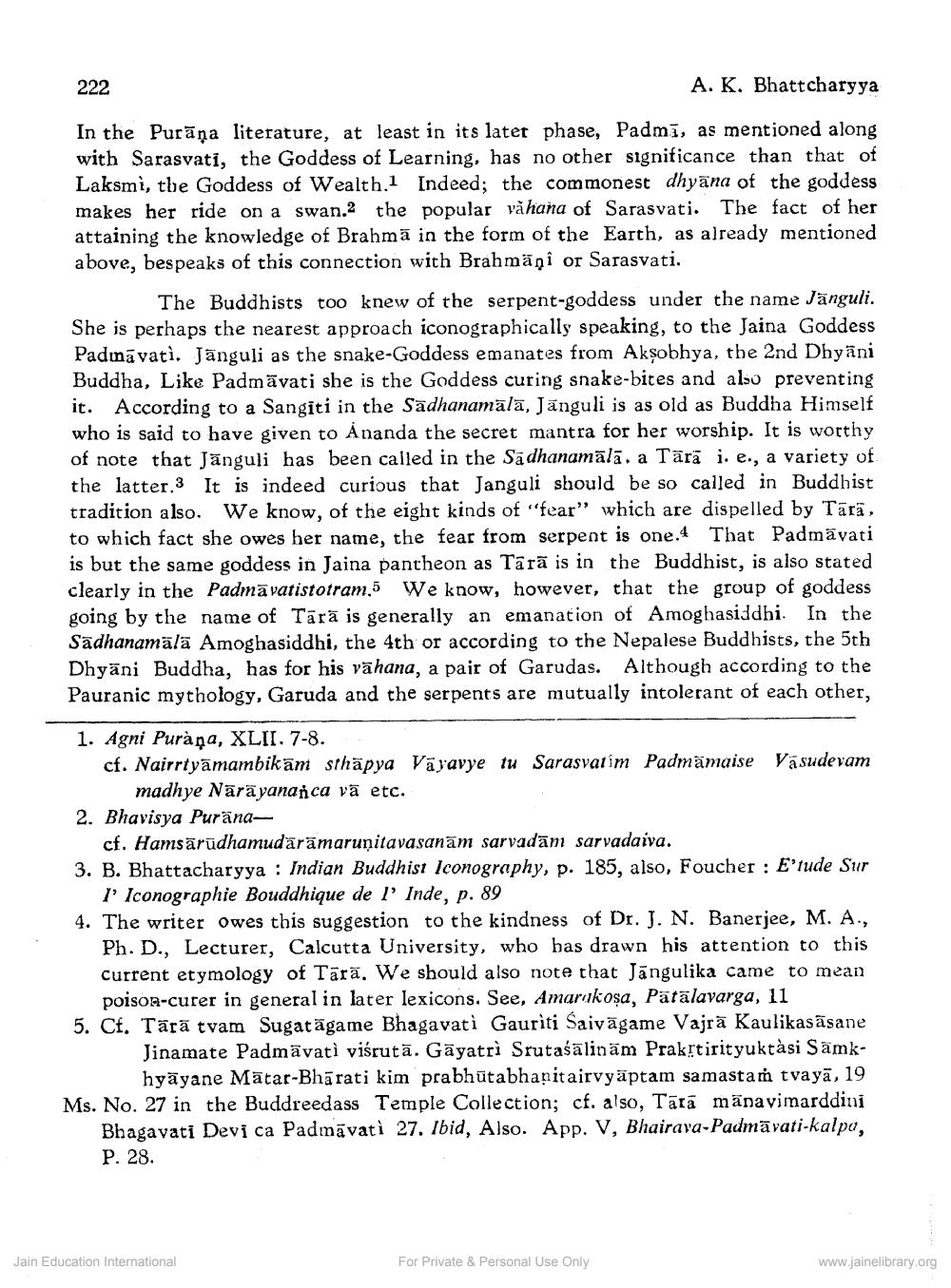________________
222
A. K. Bhattcharyya
In the Purāņa literature, at least in its latet phase, Padmī, as mentioned along with Sarasvati, the Goddess of Learning, has no other significance than that of Laksmì, the Goddess of Wealth.1 Indeed; the commonest dhyana of the goddess makes her ride on a swan.2 the popular vahana of Sarasvati. The fact of her attaining the knowledge of Brahmä in the form of the Earth, as already mentioned above, bespeaks of this connection with Brahmäni or Sarasvati.
The Buddhists too knew of the serpent-goddess under the name Jānguli. She is perhaps the nearest approach iconographically speaking, to the Jaina Goddess Padıāvati. Jänguli as the snake-Goddess emanates from Akşobhya, the 2nd Dhyāni Buddha, Like Padmavati she is the Goddess curing snake bites and also preventing it. According to a Sangiti in the Sadhanamāla, Jānguli is as old as Buddha Himself who is said to have given to Ananda the secret mantra for her worship. It is worthy of note that Jānguli has been called in the Sadhanamālā. a Tārā i. e., a variety of the latter.3 It is indeed curious that Janguli should be so called in Buddhist tradition also. We know, of the eight kinds of "fear" which are dispelled by Tara, to which fact she owes her name, the fear from serpent is one. That Padmavati is but the same goddess in Jaina pantheon as Tarā is in the Buddhist, is also stated clearly in the Padmāvatistotram, We know, however, that the group of goddess going by the name of Tārā is generally an emanation of Amoghasiddhi. In the Sadhanamälä Amoghasiddhi, the 4th or according to the Nepalese Buddhists, the 5th Dhyani Buddha, has for his vähana, a pair of Garudas. Although according to the Pauranic mythology, Garuda and the serpents are mutually intolerant of each other,
1. Agni Purana, XLII. 7-8. cf. Nairrtyāmambikām sthāpya Vāyavye tu Sarasvatim Padmämaise Vasudevam
madhye Nārāyananca vā etc. 2. Bhavisya Purana
cf. Hamsārūdhamudarāmaruņitavasanām sarvadām sarvadaiva. 3. B. Bhattacharyya : Indian Buddhist Iconography, p. 185, also, Foucher : Etude Sur
1 Iconographie Bouddhique de l'Inde, p. 89 4. The writer Owes this suggestion to the kindness of Dr. J. N. Banerjee, M. A.,
Ph.D., Lecturer, Calcutta University, who has drawn his attention to this Current etymology of Tārā. We should also note that Jāngulika came to mean
poison-curer in general in later lexicons. See, Amarukosa, Pātālavarga, 11 5. Cf. Tāsā tvam Sugatāgame Bhagavati Gauriti Saivāgame Vajrā Kaulikasāsane
Jinamate Padmavati višrutā. Gāyatri Srutaśālinām Prakrtirityuktasi Samk
hyāyane Mātar-Bharati kim prabhūtabhanitairvyäptam samastaṁ tvaya, 19 Ms. No. 27 in the Buddreedass Temple Collection; cf. also, Tārā māna vimarddini
Bhagavati Devi ca Padmavati 27. Ibid, Also. App. V, Bhairava-Padmāvati-kalpa, P. 28.
Jain Education International
For Private & Personal Use Only
www.jainelibrary.org




